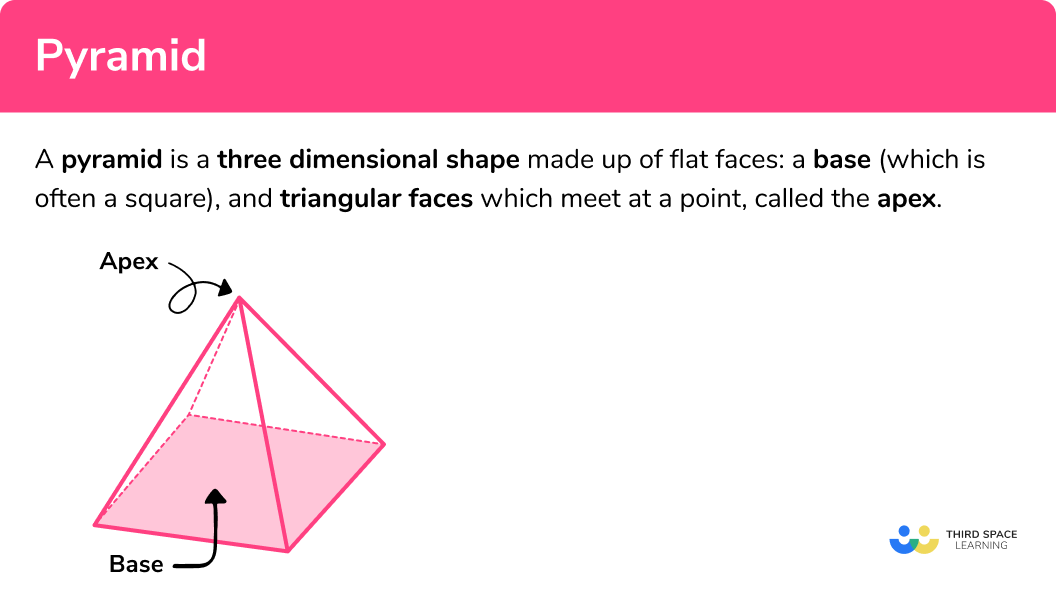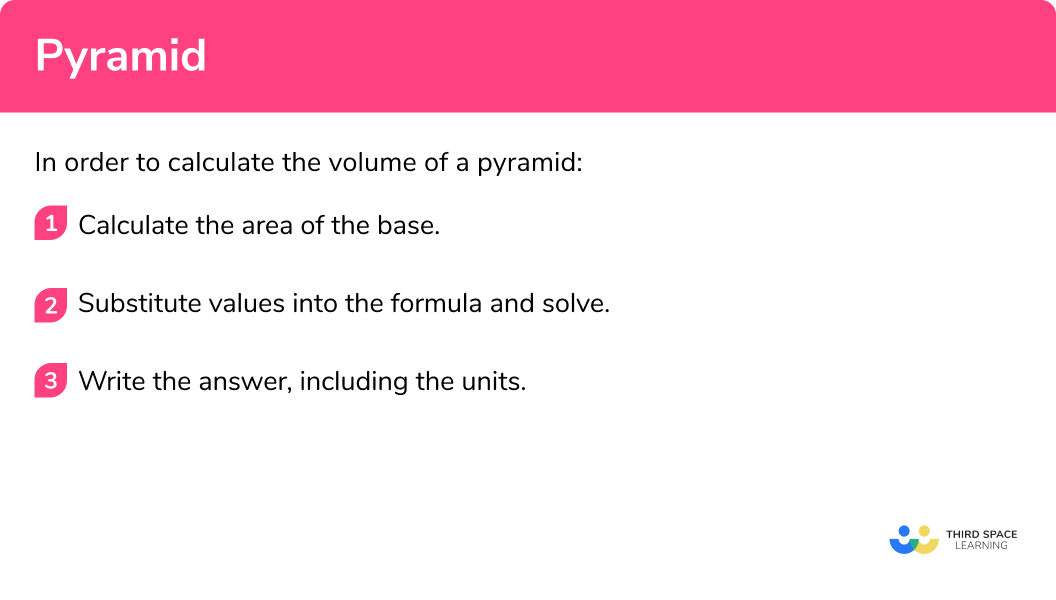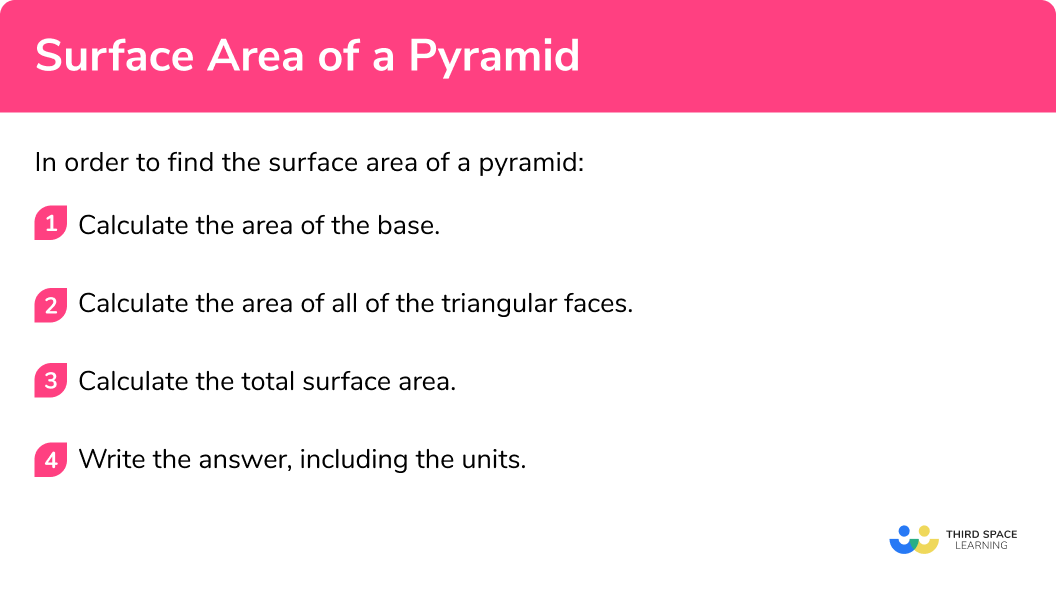GCSE Tutoring Programme
Our chosen students improved 1.19 of a grade on average - 0.45 more than those who didn't have the tutoring.
In order to access this I need to be confident with:
Faces, edges and vertices Substitution Area of a triangle Area of quadrilaterals How to calculate volume Surface area Pythagoras theoremThis topic is relevant for:

Pyramid
Here we will learn about pyramids, including what a pyramid is, how to calculate the volume of a pyramid and how to calculate the surface area of a pyramid.
There are also pyramid worksheets based on Edexcel, AQA and OCR exam questions, along with further guidance on where to go next if you’re still stuck.
What is a pyramid?
A pyramid is a three dimensional shape made up of flat faces: a polygon base and triangular lateral faces which meet at a point, called the apex. A triangular pyramid can also be called a tetrahedron, we can have different types of pyramids such as square based pyramids (like the Egyptian Pyramids), pentagonal pyramids, hexagonal pyramids etc. The base of the pyramids does not need to be a regular polygon. The base can be an irregular polygon and if the apex is not over the centre of the polygon, we call the pyramid and oblique pyramid.
Is a cone a pyramid?
A circle is not a polygon as a polygon has a finite number of edges, connected by vertices. As a pyramid has a polygonal base, the base cannot be a circle as a circle is not a polygon. So, a cone is not a pyramid.
However, the volume of a cone is still equal to V=\frac{1}{3}Bh where B=\pi{r^2}
To calculate the volume or surface area of a pyramid, we need to know certain lengths within the pyramid. Let’s look at each case separately.
Step-by-step guide: Square based pyramid
See also: Triangular based pyramid
What is a pyramid?

Volume of a pyramid
The formula for the volume of a pyrimad is same no matter if it is a regular pyramid or an irregular pyramid.
To calculate the volume of a pyramid, we use the formula:
V=\frac{1}{3}Bhwhere:
- V represents the volume of the pyramid,
- B represents the area of the base of the pyramid,
- h represents the perpendicular height of the pyramid.
This formula can be applied to any pyramid where the base is a polygon.
E.g.
Calculate the volume of the following square based pyramid:
Step-by-step guide: Volume of a pyramid
Surface area of a pyramid
As the area of each triangular face may be different, depending on each side length of the base, the formula for the surface area is a little more tricky to generalise.
However, we can still apply our knowledge of surface area to say:
The surface area of a pyramid is the total sum of the area of each face of the pyramid.
For a square based pyramid, we calculate the area of the base (a square) and the area of four identical triangles:
Note: you may need to calculate the missing length of a triangular side or slant height of the pyramid using Pythagoras’ theorem.
E.g.
Calculate the surface area of the following square based pyramid:
Step-by-step guide: Surface area of a pyramid
How to calculate the volume of a pyramid
In order to calculate the volume of a pyramid:
- Calculate the area of the base.
- Substitute values into the formula and solve.
- Write the answer, including the units.
How to calculate the volume of a pyramid


Volume and surface area of pyramids worksheet

Get your free pyramid worksheet of 20+ volume and surface area of pyramids questions and answers. Includes reasoning and applied questions.
DOWNLOAD FREE
Volume and surface area of pyramids worksheet

Get your free pyramid worksheet of 20+ volume and surface area of pyramids questions and answers. Includes reasoning and applied questions.
DOWNLOAD FREEPyramid examples
Example 1: volume of a square-based pyramid
Calculate the volume of the square based pyramid below. Write your answer to 2 decimal places.
- Calculate the area of the base.
The area of the base is:
\begin{aligned} &5.2\times 5.2={5.2}^2=27.04 \\\\ &B=27.04cm^2 \end{aligned}2Substitute values into the formula and solve.
The formula for the volume of a pyramid is: V=\frac{1}{3}Bh with B=27.04cm^2 and h=6.8cm . Substituting these values for the base and the vertical height, we have:
\begin{aligned} V&=\frac{1}{3}\times{27.04}\times{6.8}\\\\ V&=61.29066667… \end{aligned}3Write the answer, including the units.
V=61.29\text{ cm}^{3}\text{ (2dp)}Step-by-step guide: Volume of square based pyramid
Example 2: volume of a rectangular-based pyramid
The pyramid ABCDE has a rectangular base. The apex is vertically above the centre of the base. Calculate the volume of the pyramid, correct to 1 decimal place.
Calculate the area of the base.
The area of the base is:
\begin{aligned}
&6.8\times 7.2=48.96 \\\\
&B=48.96cm^2
\end{aligned}
Substitute values into the formula and solve.
The formula for the volume of a pyramid is V=\frac{1}{3}Bh , where B=48.96cm^2 and h=8.1cm . Substituting these values into the formula, we have
\begin{aligned}
V&=\frac{1}{3}\times{48.96}\times{8.1}\\\\
V&=132.192
\end{aligned}
Write the answer, including the units.
Example 3: calculating the height, given the volume
Find the height of a pyramid with volume 48 \ cm^3 and base area 15 \ cm^2 .
Calculate the area of the base.
We already know that the area of the base is 15 \ cm^2 , so we can move on to step 2 .
Substitute values into the formula and solve.
We need to use the formula for the volume of a pyramid and solve it to find the value of the height, h .
\begin{aligned} V&=\frac{1}{3}\times{B}\times{h}\\\\ 48&=\frac{1}{3}\times{15}\times{h}\\\\ 48&=5h\\\\ h&=9.6 \end{aligned}
Write the answer, including the units.
h=9.6cm .
How to calculate the surface area of a pyramid
In order to calculate the surface area of a pyramid:
- Calculate the area of the base.
- Calculate the area of all of the triangular faces.
- Calculate the total surface area.
- Write the answer, including the units.
How to calculate the surface area of a pyramid

Surface area of a pyramid examples
Example 4: finding the surface area from a 3 D diagram
The polyhedron ABCDE is a square based pyramid. The point M lies on the edge AD where AM=MD . The point E is perpendicular to the centre of the base ABCD .
Calculate the surface area of the pyramid.
Calculate the area of the base.
The area of the base is:
5\times 5=5^2=25
Calculate the area of all of the triangular faces.
The triangular face AED has a height of 7cm, and a width of 5cm. The area of a triangle is A=\frac{1}{2}\times{b}\times{h} , so the area of AED is:
\begin{aligned} A&=\frac{1}{2}\times{b}\times{h} \\\\ &=\frac{1}{2}\times{5}\times{7} \\\\ &=17.5\text{ cm}^{2} \end{aligned}
Each triangular face for a square based pyramid is congruent when the apex is directly above the centre of the base. This means that we can calculate the area of one of the triangular faces, then multiply the solution by 4 to calculate the area of all four triangles.
17.5\times{4}=70\text{ cm}^{2}
Calculate the total surface area.
The surface area ( SA ) of the pyramid is the total sum of the area of each face, giving us:
SA=25+70=95
Write the answer, including the units.
Example 5: finding the surface area from a 3 D diagram
ABCD is a triangular based pyramid.
Triangle ABC is equilateral. All of the other faces are congruent, isosceles triangles.
The point M is the midpoint of the line AC such that:
- MB=3\sqrt{3}\text{ cm}
- MC=3\text{ cm}
- MD=8\text{ cm}.
Calculate the surface area of the pyramid. Write your answer in the form a+b\sqrt{c}\text{ cm}^{2} where a, \ b, and c are integers to be found.
Calculate the area of the base.
The area of the base (which is a triangle) is:
\begin{aligned}
A&=\frac{1}{2}\times{b}\times{h}\\\\
&=\frac{1}{2}\times{6}\times{3\sqrt{3}}\\\\
&=9\sqrt{3}
\end{aligned}
Calculate the area of all of the triangular faces.
The remaining three triangular faces are all the same as stated in the question (they are congruent). This means that we can calculate the area of one of the faces, and then multiply it by 3.
The triangle ACD has a height of 8cm , and a width of 6cm (double 3cm ).
The area of triangle ACD is therefore equal to
\begin{aligned} A&=\frac{1}{2}\times{b}\times{h}\\\\ &=\frac{1}{2}\times{8}\times{6}\\\\ &=24\text{ cm}^{2} \end{aligned}
Calculate the total surface area.
The total surface area is the sum of each of the four triangles:
9\sqrt{3}+3\times 24
Write the answer, including the units.
As the question asks us to write the solution in the form a+b\sqrt{c}\text{ cm}^{2} , we have:
SA=72+9\sqrt{3}\text{ cm}^{2}
Example 6: finding the surface area from a net
Calculate the surface area of the pyramid. Give your answer correct to 2 decimal places.
Calculate the area of the base.
The area of the square base is:
7\times 7=7^2=49
Calculate the area of all of the triangular faces.
We need to add the area of the base to the area of the triangular faces.
There are 4 triangular faces.
First we need to find the height, h , of one of the triangles using Pythagoras theorem.
Now that we know the height of a triangular face, the area of the same triangular face is:
\begin{aligned} A&=\frac{1}{2}\times{7}\times{8.291561976}\\\\ &=29.02046692 \end{aligned}
The area of all four triangular faces is therefore:
29.02046692\times{4}=116.0818677.
Notice that we have not rounded any solution so far (we leave this until the very last line of calculation).
Calculate the total surface area.
The total surface area of the net is:
49+116.0818677=165.0818677
Write the answer, including the units.
Common misconceptions
- Use the perpendicular height
The height of the shape needs to be the perpendicular height. To find the volume of the pyramid we use its perpendicular height. To find the area of a triangular face we use the perpendicular height of the triangular face. It is also common to confuse the volume of a pyramid with the volume of a prism. It is important to know the difference between 3D shapes.
- Surface area has square units
The surface area will have square units such as square centimetres ( cm^2 ) or square metres ( m^2 ).
- Volume has cube units
The volume will have cube units such as cubic centimetres ( cm^3 ) or cubic metres ( m^3 ).
- Be accurate
When there are two or more steps in your workings, do not round your workings. Only round at the end of your solution so that your answer is accurate.
- Take care with rounding
At the end of the question, make sure you round your answer to the correct number of decimal places or significant figures.
Practice pyramid questions
1. Calculate the volume of the square based pyramid. Write your answer to 2 decimal places.




2. Calculate the volume of the pyramid below.




3. A pyramid has a volume of 160 \ cm^3 and the area of its base is 40 \ cm^2 . Work out the height, h , of the pyramid:




4. PQRST is a square based pyramid. The point M is the midpoint of the line RS such that RM:MS=1:1 . Calculate the surface area of the pyramid.




5. ABCDE is a square based pyramid. E is vertically above the centre of the base of the pyramid. M is the midpoint of the line AD. \ AM=4.15m and EM=10.7m.
Calculate the surface area of the pyramid. Give your answer correct to 1 decimal place.




6. Calculate the surface area of the pyramid.




First we need to find the height of the triangular face.
\begin{aligned} SA&=6^{2}+(\frac{1}{2}\times{6}\times{4})\times{4}\\\\ &=36+48\\\\ &=84\text{ cm}^{2} \end{aligned}
Pyramid GCSE questions
1. A square-based pyramid has a base with side 15 \ cm.
The perpendicular height of the pyramid is 20 \ cm.
Calculate the volume of the pyramid.
(2 marks)
(1)
1500
(1)
2. The diagram shows a square-based pyramid.
Calculate the surface area of the pyramid.
(3 marks)
(1)
4.3^2+4\times 14.62
(1)
76.97
(1)
(1)
\frac{1}{2}\times 12\times \sqrt{53}\times {2}=12\sqrt{53}
(1)
2(12\times{9})+2(10\times{9})+(12\times{10})=516
(1)
516+12\sqrt{53}+80=683.36\text{ m}^{2}\text{ (2dp)}
(1)
Learning checklist
You have now learned how to:
-
Calculate surface areas and volumes of pyramids
Still stuck?
Prepare your KS4 students for maths GCSEs success with Third Space Learning. Weekly online one to one GCSE maths revision lessons delivered by expert maths tutors.

Find out more about our GCSE maths tuition programme.